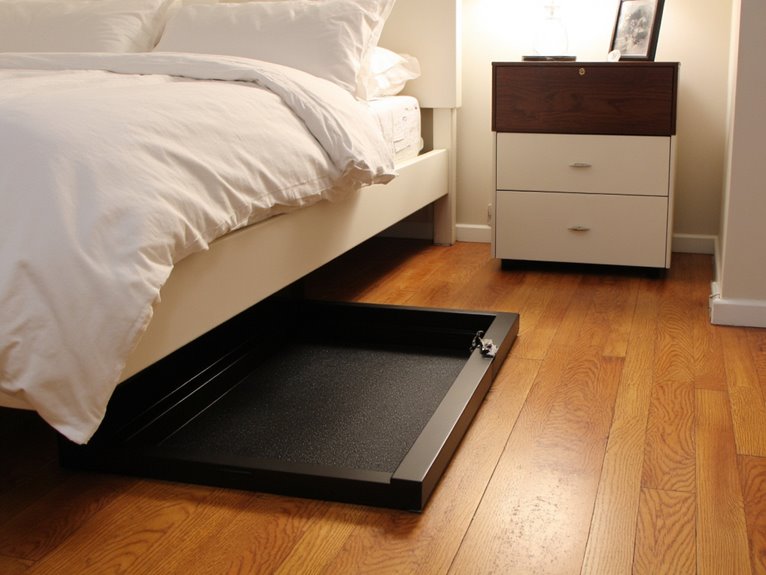Under-Bed Vs Wall-Mounted Gun Safes: Which Is Best for Your Space?
Under-bed gun safes maximize unused space with 6″ height profiles and offer 2-5 second retrieval times, making them ideal for emergency access while lying down. Wall-mounted safes feature superior 9-gauge steel construction versus under-bed models’ 12-14 gauge steel, but require standing access with 5-15 second retrieval times. Under-bed units accommodate rifles and handguns in 1-2 cubic feet of horizontal space, while wall safes limit you to handguns due to vertical orientation constraints. Exploring these five critical factors reveals which option suits your specific security needs.
We are supported by our audience. When you purchase through links on our site, we may earn an affiliate commission, at no extra cost for you. Learn more. Last update on 18th December 2025 / Images from Amazon Product Advertising API.
Notable Insights
- Under-bed safes maximize unused bedroom space while wall-mounted safes free up floor area but require adequate wall surface.
- Wall-mounted safes offer superior security with 9-gauge steel construction compared to under-bed models’ thinner 12-14 gauge steel.
- Under-bed safes provide faster emergency access (2-5 seconds) while lying down versus wall safes requiring standing (5-15 seconds).
- Under-bed safes accommodate rifles and handguns with 1-2 cubic feet capacity, while wall safes are limited to handguns.
- Under-bed safes cost $150-$700 with DIY installation, while wall safes add $100-$500+ installation costs to their price.
Space Efficiency and Installation Requirements
When choosing between under-bed and wall-mounted gun safes, space efficiency becomes your primary consideration.
Under-bed safes typically measure 6″ high, 40-48″ wide, and 15-24″ deep, capitalizing on unused horizontal space beneath your bed. This design provides excellent space optimization without cluttering your bedroom floor area.
Under-bed gun safes maximize unused space with compact 6-inch height while maintaining full bedroom floor accessibility.
Wall-mounted safes require different spatial planning. They need adequate wall surface and clearance for door operation but free up floor space entirely.
Installation flexibility varies greatly between types. Under-bed safes include pre-drilled anchor holes and mounting hardware for bed frame or floor attachment. You’ll need to verify bed frame clearance and beneath-bed accessibility.
Wall-mounted installations demand stronger structural preparation. You must identify wall studs for drywall or use masonry anchors for concrete walls, often requiring professional installation to guarantee proper weight support. Quality under-bed models are constructed from 14-gauge steel which provides substantial durability while maintaining the low profile design needed for bedroom storage. Many under-bed models feature a five-point locking bar system that significantly increases pry resistance compared to single-point locking mechanisms.
Security Features and Theft Protection
Security features separate entry-level gun safes from premium theft protection systems, with wall-mounted and under-bed models offering distinctly different defensive capabilities.
Wall-mounted safes typically use 9-gauge double-wall steel construction, while under-bed models often feature thinner 12-14 gauge steel. This thickness difference greatly impacts penetration resistance during break-in attempts.
Advanced locking mechanisms include biometric systems with fingerprint recognition offering 1-in-64-million false acceptance rates.
Multi-bolt systems with hardplates around lock areas defend against drilling attacks. Wall-mounted units incorporate stronger mounting hardware and anchors, resisting extraction attempts that easily compromise lighter under-bed safes.
Look for security ratings meeting Underwriters Laboratories Residential Security Container standards.
These certifications guarantee specific attack resistance levels, providing objective security measurements you can trust.
Premium models feature anti-theft alarms that activate during unauthorized access attempts, adding an additional layer of security beyond physical construction materials.
Proper humidity control maintains optimal conditions between 30-50% relative humidity to prevent moisture-related damage that could compromise both firearms and security mechanisms.
Accessibility and Emergency Response
Although security features protect your firearms from theft, accessibility during emergencies determines whether your gun safe serves its primary defensive purpose.
Emergency accessibility varies greatly between safe types. Under-bed safes position firearms within arm’s reach during nighttime emergencies. You won’t need to leave your bed or turn on lights. Wall-mounted safes require standing and moving to their location, adding precious seconds to retrieval efficiency.
| Feature | Under-Bed Safe | Wall-Mounted Safe |
|---|---|---|
| Access Position | Lying down | Standing/moving |
| Retrieval Time | 2-5 seconds | 5-15 seconds |
| Light Requirements | None (within reach) | May need lighting |
| Stress Response | Natural arm extension | Full body movement |
Biometric locks provide fastest access regardless of type. Under-bed models feature slide-out drawers and one-handed operation. Quick-release mechanisms respond instantly to correct inputs, while exterior LED lights facilitate dark-environment location.
Storage Capacity and Firearm Compatibility
Storage capacity differences between under-bed and wall-mounted safes directly impact your firearm collection organization and future expansion plans.
Under-bed safes typically offer 1-2 cubic feet of interior space with dimensions around 40-48″ wide, 6-7″ high, and 15-22″ deep. These storage options accommodate 1-2 rifles plus multiple handguns with 42-46″ rifle clearance.
Wall-mounted safes have smaller interior volumes due to mounting constraints. They’re often optimized for handguns or shorter firearm types rather than full-length rifles.
Under-bed units feature slide-out drawers with protective linings that prevent scratches on delicate finishes.
The horizontal configuration of under-bed safes supports mixed storage of rifles, handguns, ammunition, and accessories.
Wall safes’ vertical orientation limits rifle length and quantity, making them less suitable for extensive collections requiring diverse firearm types.
Cost Analysis and Long-Term Value
When evaluating firearm storage investments, the financial implications extend far beyond the initial purchase price. Your initial investment varies greatly between options, with under-bed safes ranging $150-$700 and wall-mounted models starting around $160-$260.
However, wall safes require professional installation adding $100-$500+ to your total cost.
Key financial considerations include:
- Installation expenses – Under-bed safes offer DIY-friendly setup versus costly professional wall modifications
- Maintenance costs – Wall safes may require reinstallation during home remodeling
- Portability value – Under-bed models relocate without structural damage or replacement needs
- Long-term durability – Wall safes potentially increase home value while under-bed options provide flexibility for renters
For reference, professional models like KAER’s wall-mounted options accommodate up to 12 rifles with scopes while maintaining compact design features that maximize space efficiency. Budget-conscious buyers should prioritize models with at least 3mm steel thickness to ensure adequate protection without compromising security standards.
Under-bed safes typically deliver superior cost efficiency, balancing security features with minimal ongoing expenses and maximum adaptability.
Frequently Asked Questions
Can Under-Bed Gun Safes Withstand Flooding or Water Damage?
No, under-bed gun safes can’t withstand flooding since they lack waterproof features and flood protection. You’ll need wall-mounted safes with certified water resistance if you’re concerned about water damage in flood-prone areas.
What Maintenance Is Required for Each Type of Gun Safe?
Both types need regular safe upkeep including humidity control and lock inspections. Under-bed safes require more frequent cleaning protocols due to floor dust exposure, while wall-mounted safes need mounting hardware checks.
Are There Legal Requirements for Gun Safe Placement in Homes?
Yes, you’ll need to follow state-specific legal guidelines for gun safe placement. These laws typically require secure storage preventing unauthorized access while ensuring you can maintain reasonable safe accessibility for lawful use.
How Do Temperature and Humidity Affect Different Safe Locations?
Under-bed locations typically experience more temperature fluctuations and humidity buildup than wall-mounted positions. You’ll need better climate control for under-bed safes since safe materials absorb moisture more readily in confined spaces.
On a final note
Your choice between under-bed and wall-mounted gun safes depends on your specific requirements. Under-bed units offer superior concealment and faster access during emergencies but limit storage capacity. Wall-mounted safes provide better theft protection through structural anchoring and accommodate various firearm sizes. Consider your available space, security priorities, and budget constraints. Both options deliver adequate protection when properly installed with quality locking mechanisms.

